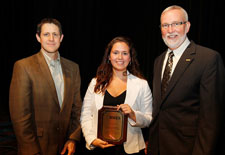
(Left to right): Kris Billiar, BMES Chair of the
Student Affairs Committee, Cassie Gorman,
URBMES chapter member, and
Dr. Richard Waugh, BMES President.
The URBiomedical Engineering
department was well represented at this year's
Biomedical Engineering
Society Annual Meeting in Hartford, Connecticut. In attendance were 5 faculty members,
including Dr. Richard Waugh
(BME Department Chair and
BMES
President), 5 graduate students, 2 staff members, and 24 undergraduate students, who presented posters and
spoke about their research.
The event was highlighted with the URBME
Student Chapter being awarded the Student Chapter Mentoring Program Award. This award recognized
the URBME
mentoring program, established in 2010 by Ben Freedman BME
'11. The program pairs upperclassmen and graduate students with freshmen and sophomores and encourages
communication between class years and the passing of knowledge about classes, workloads and in the future,
networking opportunities.